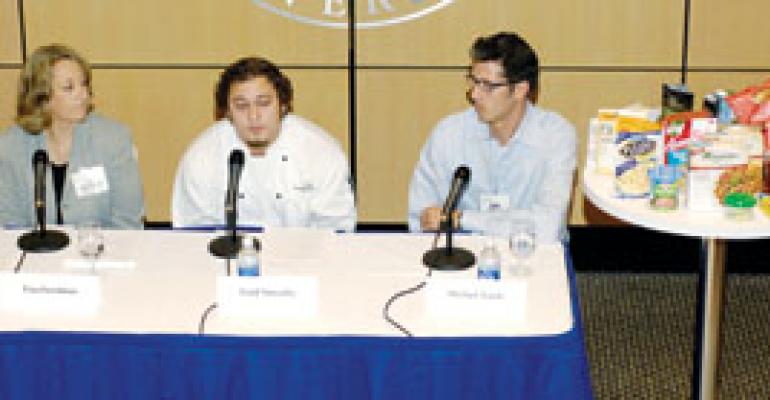Restaurant sales growth is sluggish these days, but research company Technomic expects sales of prepared food in supermarkets to grow by 7 percent this year.
As the eating public becomes more price-sensitive and supermarkets improve the food they’re selling, restaurants face a newly invigorated competitor. That was the topic of “Supermarkets Strike Back,” a panel discussion led by Nation’s Restaurant News executive food editor Pamela Parseghian.
Parseghian reviewed demographic factors that favored use of supermarkets, including research from The NPD Group indicating that consumers’ desire to save money meant they were eating at home more, and data from the Bureau of Labor Statistics that fewer women are working: around 72 percent of women aged 25-54 in 2008, compared with nearly 75 percent in 2000. NPD also indicated that people were eating dinner in restaurants less often. Dining out peaked in 1999, when consumers reported eating 20.2 percent of dinners in restaurants. In 2006, that number was down to 19.1 percent.
Parseghian also looked at marketing efforts on the part of supermarkets, which were offering gas discounts for people who earned frequent-shopper points and running ads detailing how much cheaper it was to eat at home than in restaurants. She then discussed new packaged products, many with restaurant branding, that were available in supermarkets.
That presentation was followed by a panel of former restaurant chefs: Michael Ainsle, development chef of Fresh & Easy Neighborhood Market, based in Riverside, Calif.; Todd Nowacky, food service manager of Earth Fare Market & Café, based in Asheville, N.C.; and Tina Freedman, regional prepared-foods coordinator, based in the San Francisco Bay Area, for Whole Foods Market, which is based in Austin, Texas.
Ainsle said the food they were serving was intended to provide people with meals they would otherwise get in restaurants.
“It’s not really home meal replacement anymore,” he said. “It’s restaurant meal replacement.”
Nowacky detailed the in-house preparation at his markets, which include 40-50 prepared salads in the deli case, fried chicken, grab-and-go pizza, sushi, rotisserie chicken and food for the hot buffet.
Although much of the discussion centered on the challenge posed by supermarkets to restaurants, Freedman, former executive chef for the fast-casual Fresh City chain, pointed out that the different venues could be complementary, as some food trends start in restaurants and others in supermarkets. She pointed out that the concepts could all learn from each other.
CULINARY R&D SPONSORS
| Basic American Foods | Quantum Foods |
| Bush Brothers & Company | Red Arrow Products Company |
| Clearwater Seafoods | Sargento Food Service |
| International Corporate Chefs Association | SimplotSugar Foods Corporation |
| Ocean Spray Cranberries | Sweet Street Desserts |
| Phillips Gourmet | Ventura Foods |
Ainsle said restaurants still had an advantage in terms of quality—the ability to provide different temperatures and textures in a single dish. He also pointed to the different atmosphere and service level that comes from eating in restaurants.
The supermarket focus continued on the next day of the Culinary R&D conference, when attendees had the option to visit two supermarkets in the Charlotte area. The tour started off with a trip to Harris Teeter, a locally based supermarket chain, with a wide range of prepared salads, a hot buffet, deli case and large pastry section.
That was followed by a visit to the local Earth Fare unit, with its focus on marketing local, natural and sustainable products. They wrapped up the visit with a tour of that Earth Fare unit’s kitchen, including a separate pastry kitchen.




